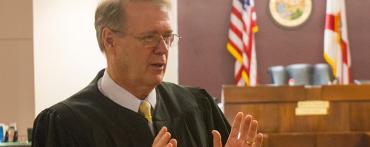
The final state redistricting trial in a nearly four-year legal battle over Florida's political boundaries ended with both sides trading charges of partisan gerrymandering, some of them the same accusations that have been hurled in court since the beginning.
In closing arguments Thursday before Leon County Circuit Judge George Reynolds, lawyers for the state Senate and a coalition of voting-rights groups made final pitches for their versions of a map for the Senate's 40 districts.
The existing map was set aside this year under a legal settlement in which the Legislature admitted the plan would likely have been struck down under a voter-approved ban on gerrymandering. Reynolds will select a plan to recommend to the Florida Supreme Court from among five maps --- one offered by the Senate and four from the voting-rights groups --- or draw his own.
In fact, lawyers for the Senate all but urged Reynolds to craft a new redistricting plan if he decides to rule that the Senate's proposal is still colored by partisan political intent.
"He seems like a very hands-on type judge," Senate Reapportionment Chairman Bill Galvano, R-Bradenton, told reporters after the arguments. "And I'd much prefer him really looking at the map versus just reaching over and pulling out one of the (voting-rights groups') maps."
But David King, a lawyer for the coalition that includes the League of Women Voters of Florida and Common Cause Florida, downplayed the possibility that Reynolds would start over with a new plan.
"That's a very daunting prospect, so I would kind of think he would choose one of the maps," King said.
Reynolds ruled against a motion by the Senate shortly before the trial that called for him to appoint a special expert who would draw a new map. But he suggested at a recent hearing that he might regret that decision if he finds all of the plans submitted by the two sides were created to help one party or another.
Both sides spent some time trying to convince him of at least half of that case. King re-emphasized the basic case that the voting-rights groups spent the entire trial making: that the Senate's proposed map is no better than the one that it would replace, one of the reasons the Supreme Court recently gave for rejecting legislative proposals for a congressional map.
"It's just like the congressional case: They get caught, they admit they're unconstitutional, and yet they come back with remedies that are as bad as the original indiscretion," King said.
But Jason Zakia, a lawyer for the Senate, countered that a series of emails about maps that the coalition crafted to submit to the Legislature in 2011 showed efforts to help Democrats. The voting-rights groups have said those emails are irrelevant to their current proposals, but Zakia said some of the ideas in the maps mirror those of four years ago.
For example, the voting-rights organizations would combine the cities of Ocala and Gainesville into a single district, creating a Democratic-leaning seat in North Florida --- something that was also in their proposed 2011 plan.
"That runs through each and every one of these maps to this day," Zakia said.
Zakia also knocked the groups' focus during the trial on the fact that their proposed maps had better scores on mathematical formulas measuring how compact the districts are, saying it could lead to unending litigation.
"It can't be that an otherwise constitutionally compliant map becomes unconstitutional once somebody else beats it. ... The point is, no matter what map you have, somebody is going to be able to beat that," he said.
But King said the gaps were notable and in line with the requirements of the Florida Constitution that districts be as compact as possible.
"This is not a situation where we're just making little ticky-tack differences in districts," he said. "These are very significant differences in compactness."
Reynolds, for his part, pressed lawyers on both sides. He noted that the map submitted to the court by the Senate was "one notch below" some of the others that had been judicially reviewed because it didn't pass a single legislative chamber. The plan was crafted by Galvano after the collapse of a special legislative session last month.
At the same time, he underscored the fact that even if he becomes skeptical of the legislative map, the proposals from King's clients also have to be reviewed.
"That map has to undergo at least a certain level of scrutiny," Reynolds said.


